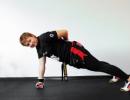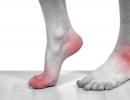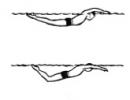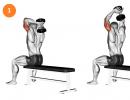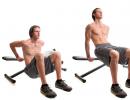Leaning forward from a standing position. Tilts forward from a standing position on the gymnastic bench. Throwing a tennis ball at a target
TRP standards are developed taking into account the physiological characteristics of the sexes, age groups And physical condition participants.  Forward bends are mandatory or alternative views exercises for all age groups, but the starting position and the result that a participant of a certain gender and age must show in order to complete a certain TRP sign differ.
Forward bends are mandatory or alternative views exercises for all age groups, but the starting position and the result that a participant of a certain gender and age must show in order to complete a certain TRP sign differ.
From a standing position on the floor or on a gymnastic bench, the exercise is performed by boys and girls aged 6-15, men and women aged 40 and above without age restrictions, as well as men and women 30-39 years old to fulfill the standards of the TRP bronze badge. The rest of the categories of participants perform the exercise from a standing position on the gymnastic bench, while depending on age, gender and the fulfillment of the standard of a certain TRP sign, the height from which they must reach the floor changes from +2 to +16 cm.
Boys and girls aged 6-15 years old must reach the floor with their fingers to fulfill the standards of the bronze and silver signs of the TRP, and the golden sign with their palms. Men and women 40-59 years old should reach the floor with their fingers, and older ankle joints.
Exercise technique
To avoid injury when performing forward bends, especially for athletes performing bends with a barbell, the following technique must be strictly observed:
- in the initial position, the legs should be placed shoulder-width apart, the body is straightened with a slight deflection in the lower back;
- at the beginning of the exercise, the participant takes a deep breath, holds his breath, bends over smoothly, making sure that the back is even with a slight deflection in the lower back and lowered to a position parallel to the floor sports hall, and the head is raised;
- before lifting to the starting position, an exhalation is made, the body must be lifted smoothly, including the muscles of the buttocks and biceps of the thighs, but without straining the lower back.
Technique for performing inclinations in yoga practice:
Pain when bending forward
Pain in the lower back or back is manifested in osteochondrosis and other diseases of the spine. Depending on the stage of the disease, pain can be moderate, tolerable, severe, acute, dull or aching. When pain occurs, regardless of the degree of its manifestation, it is necessary to consult with a vertebrologist, osteopath and neurologist. These specialists refer to differentiated diagnostics (X-ray, MRI, CT scan and passing the necessary tests), determine the cause of the pain, and with the help of physiotherapy exercises, manual or reflexology, as well as other methods eliminate it.
In connection with the spread of computer technology, schoolchildren and students change their study desk for a computer desk during the day, and employees of institutions change their office desk for a computer desk or a car, lead a hypodynamic lifestyle and get used to stooping. Therefore, problems of the spine are manifested not only in the elderly, but also at school age.
Before passing the TRP standards, it is imperative to eliminate the cause of back pain that occurs when performing the “forward bends” exercise.
And this video is with barbell bends.
Headache
If a sudden headache regularly occurs when bending forward, this is a symptom of a possible disease with sinusitis, acute respiratory infections, influenza, migraine, hypertension, mental fatigue and others, for example, a disease cervical spine. In any case, the regular manifestation of headache when performing forward bends is the basis for contacting a general practitioner who will decide on the method of diagnosing the disease and the need to contact a specialized doctor (vertebrologist, neurologist, psychotherapist, traumatologist, ENT, cardiologist). Self-administration of painkillers does not eliminate the cause of the disease, it is necessary to accurately diagnose the disease and treat it.
The benefits and harms of exercise

The manifestation of pain in the lower back, back, head was the cause of controversy about the benefits or harms of this exercise. For a person who has not found out the cause of the pain that has arisen and has not eliminated it, as well as for a participant who violates the technique of performing this exercise, it can be harmful. For a healthy person, this universal exercise for women and men combines the work of several muscle groups, developing, strengthening them, creating a perfect figure and maintaining the elasticity and mobility of the spine. Therefore, forward slopes are included in the standards of all stages of the TRP.
| Step (age) | Girls | boys | ||||
|---|---|---|---|---|---|---|
| 1 step - for 6-8 years | +3 | +5 | +9 | +1 | +3 | +7 |
| Stage 2 - for 9-10 years | +3 | +5 | +11 | +2 | +4 | +8 |
| 3rd step - for 11-12 years old | +4 | +6 | +13 | +3 | +5 | +9 |
| 4th step - for 13-15 years old | +5 | +8 | +15 | +4 | +6 | +11 |
| 5th step - for 16-17 years old | +7 | +9 | +16 | +6 | +8 | +13 |
| Step (age) | Women | Men | ||||
| 6th step - for 18-24 years old | +8 | +11 | +16 | +6 | +8 | +13 |
| 6 step - for 25-29 years | +7 | +9 | +14 | +5 | +7 | +12 |
| 7th step - for 30-34 years old | +5 | +7 | +13 | +3 | +5 | +11 |
| 7th step - for 35-39 years old | +4 | +6 | +12 | +2 | +4 | +10 |
| 8 step - for 40-44 years | +2 | +4 | +11 | +1 | +3 | +9 |
| 8 step - for 45-49 years | +2 | +4 | +10 | +0 | +2 | +8 |
| 9th step - for 50-54 years old | +1 | +3 | +9 | -1 | +1 | +7 |
| 9th step - for 55-59 years old | +1 | +3 | +8 | -2 | +0 | +5 |
| 10th step - for 60-64 years old | +0 | +2 | +6 | -6 | -4 | -1 |
| 10th step - for 65-69 years old | -4 | -1 | +2 | -8 | -6 | -4 |
| Level 11 - for 70 years and older | -6 | -4 | +0 | -10 | -8 | -6 |
Basic rules for passing the exercise:
This TRP test is performed from a standing position. The athlete stands on the floor or on a special gymnastic bench. Legs should be straight. The feet are parallel, the distance between them is about 10-15 cm.
Floor test
During the test, the athlete performs two training slopes, on the third time he must touch the floor with his fingers and stay in this position for 2 seconds. Standing on the floor, participants from 6 to 15 years old and over 40 years old are tested. It is also permissible to pass such a test at the age of 30-39 if you pass for a bronze TRP badge.
Bench test
If the test is carried out on a gymnastic bench, then at the third inclination, the subject must bend as much as possible and hold the touch on the ruler for 2 seconds. The amount of flexibility of the athlete is measured in cm. If the participant could not bend down below the level of the bench, a “-” sign is put. On the gymnastic bench, the exercise is performed by participants from 15 to 40 years old.

When do results not count?
The results are not counted if the athlete bends his knees when bending over, if he was unable to keep his hands on the ruler for 2 seconds, or if he held the result only with the fingers of one hand. 
Hello our young readers! Today in our already traditional heading "Pull up to the sport!" we continue to tell you about the types of tests / tests of the All-Russian physical culture - sports complex"Ready for work and defense." According to a good tradition, the owner of the golden sign of the TRP, a participant in the All-Russian Festival of the VFSK TRP as part of the Lipetsk region team, a student of the Lipetsk Lyceum No. 44, Sevastyan Shamaev, helps us in this. Today he will tell us and show us how to correctly fulfill the standard "forward bend from a standing position on the gymnastic bench." In the TRP complex, this test is mandatory for all levels, both for boys and girls.
 Tilt forward from a standing position with straight legs is performed from the starting position: standing on a gymnastic bench, legs are straightened at the knees, the feet are parallel at a width of 10-15 cm (Photo 1).
Tilt forward from a standing position with straight legs is performed from the starting position: standing on a gymnastic bench, legs are straightened at the knees, the feet are parallel at a width of 10-15 cm (Photo 1).
The participant performs an exercise in sportswear, allowing the judges to determine the straightening of the legs at the knees (shorts, leggings, etc.).
 When performing a test at the command of the judge, the participant performs two preliminary inclinations (Photo 2), sliding your fingers along the ruler of measurement.
When performing a test at the command of the judge, the participant performs two preliminary inclinations (Photo 2), sliding your fingers along the ruler of measurement.
 At the third tilt, the participant bends as much as possible and fixes the result for two seconds. (Photo 3).
At the third tilt, the participant bends as much as possible and fixes the result for two seconds. (Photo 3).
Flexibility is measured in centimeters. The result above the level of the gymnastic bench is determined by the sign - , below - by the sign + .
Errors in the execution of the test, in which the execution does not count:
- bending the legs at the knees;
- fixing the result with the fingers of one hand;
- no fixation of the result within two seconds.
This is how easily and simply this standard is met. In the next issue of the heading "Pull up to the sport!" we will tell you how to perform a long jump from a place with a push with two legs. See you soon, Friends!
Forward bends are a simple exercise known to many since childhood, which allows you to develop the flexibility of the spine and tone the muscles of the press, back and buttocks. In addition, this exercise is included in the TRP standards. Therefore, for all those who want to have a beautiful flexible body and be proud of your physical form, forward bending is a mandatory item in the program.
Why do?
Leaning the body forward is a completely natural movement for human body. The exercise does not require any physical training or sports equipment. It is ideal for self-training, at home.
Effect on the body:
- Forward torso improves spine flexibility and hip joint mobility.
- There is a stretching training for the hamstrings and muscles of the back of the thighs. Especially if you are doing the exercise with straight legs.
- Strengthening the muscles of the press, back, buttocks.
- Improving blood circulation, preventing diseases of the vessels of the head.
Contraindications
In fairness, it should be noted that forward bends from a standing position, like any other exercise, have contraindications. In fact, they are associated with two features of movement: the inverted position of the body and the impact on the spine. Under certain conditions of the body, these effects are undesirable:
- High blood pressure, headaches, diseases of the vessels of the head.
- Problems with the spine, in which the tension of the muscles of the lumbar region is not recommended.
Often, with problems with the spine, it is recommended not to tilt from a standing position, but to raise the pelvis from a squatting position, while leaving your hands down. Due to this, the position when the body is parallel to the floor is excluded from the exercise. It is this position that requires maximum tension in the muscles of the lower back. After all, when you have already bent over, the back muscles are relaxed.
Execution technique
Despite the popularity of the exercise, the technique of its implementation has its own characteristics. Let's consider it in more detail.
- Stand up straight, place your feet shoulder-width apart, straighten your back. The lower back should be in a natural curve, rib cage should be straightened out.
- Tighten your abs and, keeping your back straight, lower your body down, twisting in hip joints. If your current level of flexibility does not allow you to reach the floor with your hands, do not round your back, but bend your knees slightly. Flexibility will develop over time, and you will be able to fully perform a forward bend with straight legs.
- Hold at the bottom point for 1-2 seconds and with effort gluteal muscles return to starting position. Perform the desired number of repetitions.
All the time, focus on the fact that you are not pulling the body up due to the muscles of the back. This is not only wrong, but also dangerous. The back muscles keep the body in a straight position, and raise its gluteal muscles.
Also, while bending the torso forward, attention should be paid to breathing. Expert opinions differ on this point. The easiest and safest option is to stick to the anatomical features of the human body. Namely, in a standing position, the chest is straightened, the lungs can accommodate a sufficient amount of air. At the bottom, vice versa. Therefore, it is logical to lower the body on the exhale and raise it on the inhale.
You can start by doing 10-15 tilts in 2-3 sets. The exercise should be done at a slow pace, without jerking, completely under control. Strive to lower yourself from a standing position into an incline with straight legs.
I must say right away that people at the moment suffering from intracranial pressure (expressed in perceptible pressure on the eyeballs, headaches, swelling of the body and general increased blood pressure) this exercise should be left until "remission". It is necessary to train the vascular system (there are many ways). But it's not worth the risk of such an exercise, any additional unprepared rush of blood to the head in case of increased pressure can cause vascular rupture ... and you know what it is. Therefore, everything that is done is done with the mind and understanding of one's CURRENT state.
However, the presence of diseases and pains is not a reason to lie down and not move, only movement and careful exercises allow you to eventually get out of any severe and neglected state of the disease. The main thing is to read softly and gradually.
So, forward bending of the body, both sitting and standing, is a way to stretch the space of the intervertebral discs, which improves flexibility (due to the work of the ligamentous apparatus), stretches the muscles, improves blood circulation and, as a result, improves well-being and prepares for further physical activity. Exercises are recommended to be done in the morning and in the evening. In the morning, while the spine is the most flexible to start the day, in the evening to eliminate "sagging" (after all, no one has canceled the force of gravity). Standing bends differ from seated bends mainly in that standing is assisted by the same force of gravity that has been "flattening" you in your entire life. In other words, leaning forward is easier! (unless you have the problems described in the first paragraph).
Sitting it looks like this and ideal with constant practice
And so - when we do, not practicing yoga
Before leaning forward, it would not be bad to pull the body up, the hands are also stretched to the top. The point of the upward stretch (horizontal, which is even better) is to get your chest and ribs moving so that you work your diaphragm. Take a deep breath in as you raise your arm and exhale as you lower it.
IMPORTANT: when in sports during exercises people think about how to breathe correctly, the answers are different and all unreasonable. There is only one rationale for breathing: your body breathes simply: by bending you reduce the volume of the lungs - this is always an exhalation, by unbending - you increase the volume of the lungs - this is an inhalation and nothing else. Anything that doesn't bother you!
So, when you "stretched" and "breathed" according to the logic, take a breath and slowly exhale begin to tilt. Everything is also simple here and in a couple of days you will be able to touch the floor with at least your fingers, and how it should be with your palms (here from yoga you can switch to poses when you step on your hands, when you touch your knees with your head and beyond, it all comes from desire and flexibility and your goals).
Just like in the picture
A good start is when you already know how to do this, but often due to the fact that we remember that it can do this over time, without checking it, we see that we can’t do it too much, either the legs bend or touch for a split second:
You have to ACT like this:
1) legs are ALWAYS straight.
2) at the beginning of the tilt, the body goes back (this is movement compensation to stabilize the "figure", later you will stand up straight)
3) your hands (hands) should "slide" on the hips-knees-shins-feet and further to the floor. Sliding means that you get to a place where you are comfortable and the pulling sensations do not cause much discomfort, then wait until gravity itself pulls your body down and you go down another couple of centimeters. Then straighten up and rest, repeat again. You will be surprised how quickly everything will turn out for 3-4 days.
4) the whole exercise on a slow exhalation
5) in the exercise you pull the back of the thigh, the calves are also felt, we are not afraid of the pulling sensations. STOP WHEN STRONG PAIN STARTS! rest and try again after 5-10 minutes and slowly, until the exhalation breath is enough.
6) no stars in front of the eyes, no "leads to the side." All "special effects" speak of a weak vascular system and poor functioning of the vestibular apparatus, it's all training, the main thing is not to give up, but you don't need to jump above your head either. Do the same exercise after it turns out while sitting (but sitting often you need an assistant who presses on your back, so sitting is easier to do when you can already stand)
7) MOST IMPORTANT when bending over, you should not feel panic or fear or tension. In other words, the main thing is to work with your thoughts, to understand that tilting and touching the floor is inherent in you by nature and scoliosis and other deviations will not interfere with you. It's all about practice. You don’t need to do anything by force, gravity itself will help you, if you relax in the process of doing it, then the muscles and ligaments will respond to you with gratitude and greater flexibility. You yourself do 50% of extra body contractions even when it is not necessary, just thinking that there is no other way.
YOU know that a skeleton with a ligamentous apparatus can be stable without muscles, this is ideal system balanced and returns itself to its place. Often you yourself do not allow yourself to recover by forcing your muscles to perform an extra function or not using them enough, which prevents the "skeleton" from effectively performing its function. Thus, muscle overstrain deprives the balance of the spine, additionally loading it by the fact that the muscle "pulls" the spine towards itself. A properly developed muscular frame with a good ligamentous apparatus is a guarantee of health and the absence of pain, and as a result, youth.
Below are some of the yoga asanas (I don’t do them, but I think it would be good for general development)
Write what was difficult or easy. And who can sit like in the second photo from the top, where


